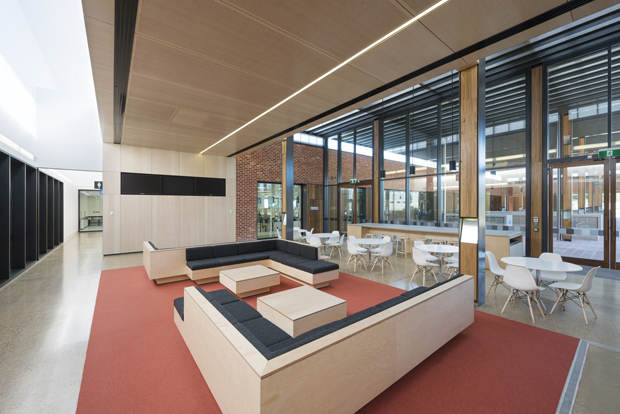The National Life Sciences Hub (NaLSH) is the new teaching and research facility for the life sciences at Charles Sturt University’s Wagga Wagga campus.
Organised in an ‘L’ shape, it has been sited to define and terminate a new avenue in the precinct. The two wings house student teaching laboratories and research laboratories which are folded around an entry foyer.
At the entry the roof is raised to form the verandah, which not only terminates the avenue, but is the principal gathering space for the NaLSH. Together the verandah and foyer form a nexus between research and teaching, supporting interactions between the schools, researchers and students.
The NaLSH project has sought to develop an appropriate tectonic expression of place, both through the site’s geology and built context. The use of red recycled clay brickwork consciously builds on a history of distinctive masonry construction in the Wagga Wagga region, and suggests a new formal language for the campus, literally derived from its alluvial clay soils.
With a 5 Star Green Star target, the project focused on energy, water and waste, all enhanced by the use of the recycled red clay bricks. The design is sustainable at both physical and social levels.

INITIATIVES
-
Excellence in environmental performance for laboratory buildings with strict climatic controls.
-
Maximised evaporative systems.
-
Energy data logged through sensors every 15 minutes to identify inefficiencies and ensure modifications.
-
Rainwater collection from the roof measuring 4750m² and collected in a 80,000L underwater tank.
-
Collected water treated for use in toilets and irrigation.
-
Water consumption rate monitored in order to detect leaks and reduce usage.
-
Waste monitored and targets set on a yearly basis.
-
Recycled brick used in double brick construction with wide cavity following thermal mass studies.
-
Strong use of natural light significantly reducing need for artificial light.
-
Verandah space modelled to maximise shade and coolth in summer and maximize sunlight penetration in winter.
Images: John Gollings.

